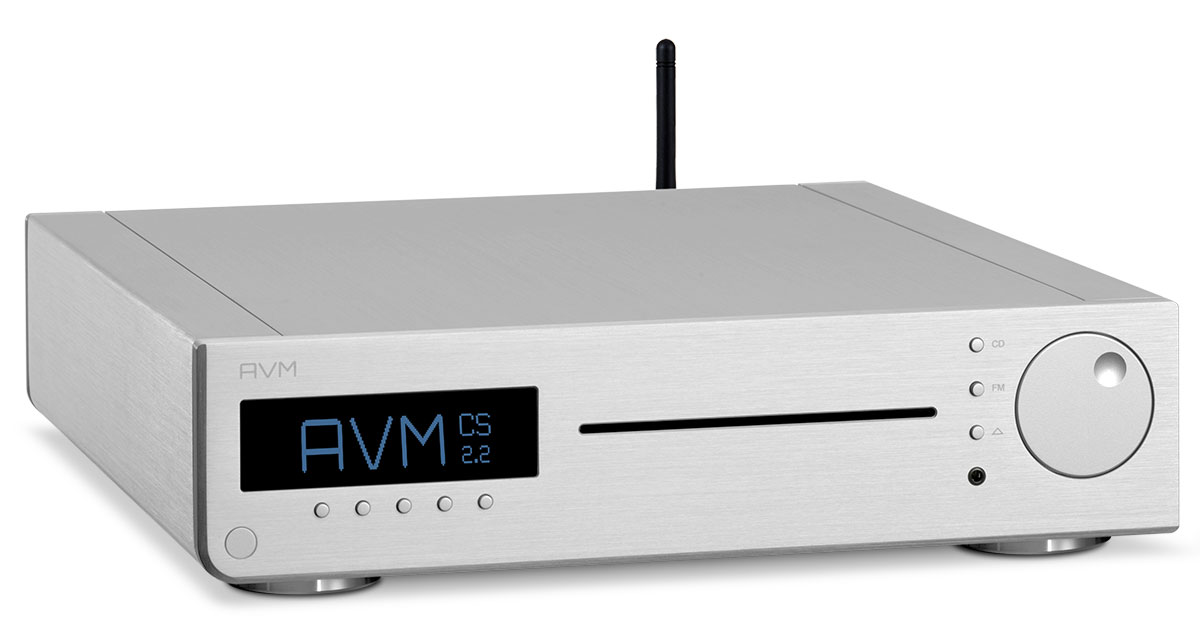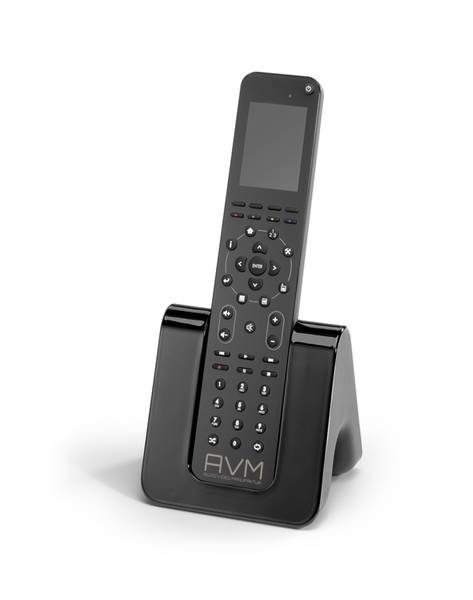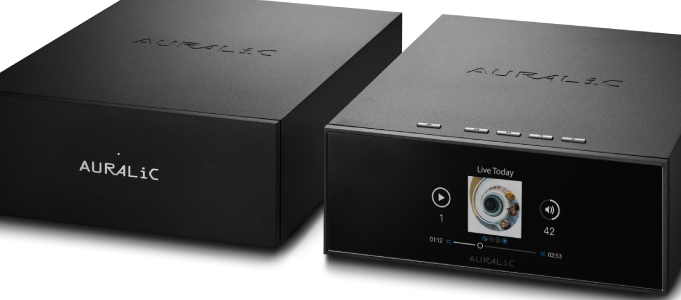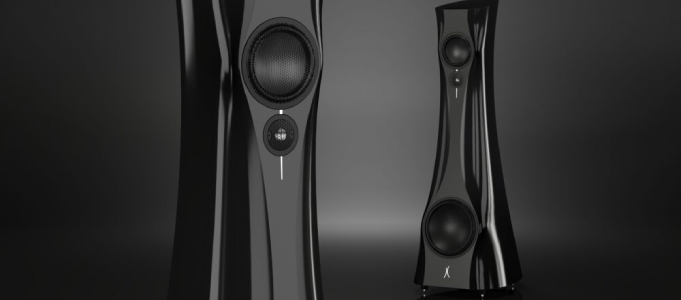AVM Inspiration CS 2.2 CD-Receiver Review

If you’re looking for a high quality European all-in-one unit for work or home, then the Inspiration CS 2.2 might be just the ticket. One unit that will do practically everything, play CD’s, the radio, stream files, connect to a turntable and have enough power to play most speakers; truly universal. Made by AVM GmbH or ‘Audio Video Manufaktur’ in Germany, the Inspiration CS 2.2 is literally packed full of features, and delivers on all fronts.
AVM have been manufacturing high quality electronic equipment for more than 20 years now, so they are not newcomers to the industry. This is seen in the maturity and quality of the products that they make. They specialise in CD players, amplifiers and multi-purpose receivers, where they seem to want to cram in as much technology and functionality as possible into a small space. This is not at the detriment to quality however. They particularly care about how their products sound, being well aware that every electronic circuit leaves its own individual “fingerprint” on the reproduced music signal. So, when they engineer new components, they try to keep the “fingerprints” as inaudible as possible, resulting in a better musical experience for both you and me.
The Inspiration CS 2.2 ($7256 RRP as suppled) is described as a compact streaming CD player receiver, but as mentioned at the start of this article, it’s much more than that. The CS 2.2 offers a large variety of connectivity and control functions. All the well-known file formats are supported when music is streamed from different sources. The supported streaming formats include: MP3, WMA, AAC, OGG Vorbis, FLAC (192/32 via LAN), WAV (192/32 via LAN), AIFF (192/32 via LAN), ALAC (96/24 via LAN) There is currently no support for DSD files. It will also support UPnP 1.1, UPnP-AV and DLNA-compatible servers. AVM’s Australian distributor, National Audio Group, told us that there is an upcoming firmware release that will enable Tidal and Spotify streaming, but it wasn’t released at the time of this review.

The CS 2.2 offers a variety of digital inputs like synchronous USB input, optical and SPDIF inputs and outputs. NAS (network attached storage) and external USB drives are also supported. There is a Phono stage on board that will accommodate both MC and MM cartridges, as well as 3 line inputs. There is a pre out and line out to connect additional equipment, an FM tuner, web radio with vTuner services, DAC with 192 kHz / 24 Bit resolution (it up-samples all incoming digital signals to this resolution.) Finally, for head-fi listeners there is also a class-A headphone output with 3.5 mm socket.
The amplifier section uses a proprietary implementation of Hypex’s UcD switching module for each channel. This allows the amplifier to be manufactured into a small form factor, negating the need for large, heavy heatsinks and allows it to be very energy efficient. It endows the CS 2.2 with a claimed power rating of 2 x 110 W into 8 Ω.
Interestingly I found that the speaker connections are not the standard multi way post, but rather a BFA connector. The BFA connector is a safety plug/socket system that uses a sleeve rather than a pin on the plug. It is meant to be a safer EU standard, but you can also use a standard 4mm banana plug directly into the socket.
Setup
 The unit that I received for review was a unit that had been well used before it made its way to me. Before I plugged in the unit to my system, I connected up the AC and plugged in an Ethernet cable, then took a good look at the front panel controls. It is really quite understated with only 9 buttons and a rotary volume control. There is a good sized 100mm blue graphic display that reads out the settings, volume and the specific names of the buttons for a given menu. The looks invoke a luxury European feel.
The unit that I received for review was a unit that had been well used before it made its way to me. Before I plugged in the unit to my system, I connected up the AC and plugged in an Ethernet cable, then took a good look at the front panel controls. It is really quite understated with only 9 buttons and a rotary volume control. There is a good sized 100mm blue graphic display that reads out the settings, volume and the specific names of the buttons for a given menu. The looks invoke a luxury European feel.
If you want to get into the multitude of settings and sub-menus, you will need to use the supplied remote control. It is a collection of 45 buttons, plus a useful color display. It is a battery operated device equipped with internal rechargeable batteries, so a charge is a must before use. It’s refreshing to see a specifically designed remote control, rather than an off-the-shelf solution as some manufacturers employ. There is a supplied cradle charger as well as a USB cable, so it’s easy to charge it on any modern smartphone or tablet charger. In the meantime, I started reading the detailed 25 page Operation Manual. It has many more functions, settings and flexibility than the simple faced front panel would seem to indicate. This is a full featured streamer with great features, in a small and demure package.
As the unit was already used, I decided to do a factory reset on it, so that I would have the same user experience as someone who had just purchased the CS 2.2. With the remote control charged, it was time to pair the remote to the unit. This is simply done by selecting the menu item, switching on the unit and pressing enter. It takes about 5 seconds to do. I also checked the firmware for updates, which is another couple of button presses away. The latest was already installed, V0.14.
With everything working, I decided to install the AVM application from the App Store onto my Apple iPod, which took about a minute. It will discover the AVM base station and selecting it will instantly pair the iPod to the unit. Most, if not all of the functions of the remote control are duplicated on the iPod, with the benefit of finding your music on the network, displaying and controlling it on a device with a decent size screen. The app is also available for Android. It is impressively versatile and user friendly. You certainly don’t need a degree in computer science to be able to operate it.
Having that preliminary work taken care of, I connected via Ethernet connection (there is also a WLAN antenna for wireless connectivity) to my NAS, power and speakers. Firstly they were connected to Wilson Benesch Vector loudspeakers, which although expensive for a modest system, proved to be a good pairing.

Listening Impressions
The first track that I listened to was from Jimmy Little’s Aria Winning Album “Messenger”, “The Way I Made You Feel”. I was impressed, Jimmy’s voice was calm and deliberate, the track has a swagger and it immediately got me involved and I found myself nodding my head and tapping my foot in tune. Music is presented from a nice quiet background and the sound easily jumps out of the speakers with drive and a good amount of bass control. The bass has sufficient speed and extension; far more than a pint sized box would otherwise seem to indicate. The midrange is clean and uncluttered, with plenty of detail and articulation. The sound stage was lovely with a tall, wide image and a reasonable amount of front to back depth.
Nick Cave “Red Right Hand” sounded clean, vibrant and powerful. The snare drum brushwork sounded a little brittle and etched, otherwise very good. The struck bell was particularly clear and lifelike.
Also on the same “Best of” Nick Cave & the Bad Seeds album is “Into My Arms” where a piano dominates the backing. It sounded very good, clean with natural harmonics. The definition between the lower registers of the piano and the bass guitar was excellent.
“Kata” is a track off the album “No Fear, No Die” by South African jazz pianist Dollar Brand, who is better known as Abdullah Ibrahim. The track is spacious sounding, musical and the saxophone has body and it correctly sounds like it has been made of brass. With top shelf musicians to accompany him, this is a great album and it has been nicely recorded. There is a slight amount of mid treble harshness evident, which can tend to make the cymbals sound a bit thin. Miles Davis' Kind of Blue album confirmed this, sounding a little thin and threadbare in some of the soft passages with the trumpet. With a touch of treble edginess in just a few tracks that I played, I feel that you will need to match the CS 2.2 with speakers that are a little tame in the top end for a long term successful matching.
I also used the CS 2.2 with a pair of Audiovector SR 1 Signature series, which are a medium sized stand mount speaker. They proved to be nice and open sounding, clean and very detailed as a combination. They are not really a full range speaker as they have a somewhat limited bass response, but they are very smooth and worked well with the CS 2.2. Often the smaller speakers are not as efficient as a larger floor stander, hence they benefit from having an amplifier with quite a lot of power. Yet the CS 2.2 proved to have more than adequate power reserves to drive them cleanly and loudly.
Playing “Born to Die” by Lana Del Rey was another good match for the capabilities of the CS 2.2, it sounded remarkable. There was so much front to back depth, it was very easy to listen to and I enjoyed it immensely. Her voice has a lot of reverb added and it sounds very clear and detailed. Another track that sounded great was The Black Eyed Peas “Shut Up”. It really boogied with a nice driving bass line and good separation between the singers and instruments. It was capable of being played loudly, with good control, bass extension and drive.
Because most folks want to have what they consider ‘good sound’, that is, a sound that is subjectively preferred by them, a feature that could be useful is the inbuilt tone controls. The CS 2.2 provides bass, treble and loudness tone controls as a handy way to tailor the EQ curve to suit your individual needs. This can especially aid speakers placed in a location that is less than ideal. You can even set the tone controls specifically for an individual input, such is the versatility of the AVM.
Gotye “Seven Hours with a Backseat Driver” has a number of different elements and sound bites that contribute to the track and give it an early 20th century type of old fashioned feel. I liked the way that each element sounded unique and added depth and interest to the track. The CS 2.2 did a splendid job of layering the sounds. The rhythm and timing is spot on and the sound stage was broad and well filled.
I really appreciated the ability to use the remote control from all over the house. It is radio controlled rather than infrared, so I found that I could sit in the study, reading or typing, and skip tracks, change the volume or anything else that pleased me. It was a very handy feature and something that could tip the decision towards the purchase of an AVM when comparing it against its competition. It’s so practical, why don’t more manufacturers do this?
I wasn’t able to try the phono input of the CS 2.2, but have been reliably advised that it works well and that its sound quality is complementary to the rest of the inputs. I was able however to compare the sound of an external CD transport to the internal drive. I have to admit that I was stunned with how good the internal drive sounded compared to an expensive external drive using the coax digital input. It was very close indeed and testament to the tuning and care taken by the designers at AVM. The on-board DAC no doubt played a large part of the overall sound quality of the unit, with automatic up sampling to 192kHz/24bit from every digital source.
 I plugged in a USB stick into the rear input socket of the receiver that was mixed with WAV, FLAC and MP3 files and it played them all, easily and with no fuss at all. Both the remote control and iPad contained the track name, bit depth and other information on the screen and navigation was intuitive. The same goes for other files that are on my home network, including another USB stick plugged into my NBN router. All the files were discovered and listed on the screen in a matter of seconds.
I plugged in a USB stick into the rear input socket of the receiver that was mixed with WAV, FLAC and MP3 files and it played them all, easily and with no fuss at all. Both the remote control and iPad contained the track name, bit depth and other information on the screen and navigation was intuitive. The same goes for other files that are on my home network, including another USB stick plugged into my NBN router. All the files were discovered and listed on the screen in a matter of seconds.
The internet radio function worked faultlessly, pre-set with popular stations displayed for quick access. It also has the ability to search and store your own favourite stations from anywhere around the world. There are so many features and user selectable options that are available that I recommend that you read the manual, or have a look on the web for a comprehensive listing. I was still learning its secrets when I had to return the unit.
Conclusion
The AVM Inspiration CS 2.2 is the simplest and most versatile multi-function, single-box solution that I have used. It’s like the Swiss army knife of receivers. It is thoroughly modern in its design and execution, doing away with unnecessary bulk, complexity and high running costs. It would look great in anyone’s home or office and it is powerful enough to work well with a wide variety of speakers. The firmware of the streaming client is upgradeable, essentially making the CS 2.2 future proof. It is a thoroughly modern 21st century product.
The sound quality is also impressive, with an open, articulate and highly detailed sound that is engaging. It is more dynamic than many other small receivers due to its switching Hypex output stage, with very little heat generated. The review sample operated faultlessly and the operating software was easy to use and extremely stable. Being made in Germany it exuded a certain European quality and charm with every interaction that I had with it. Even though it is not inexpensive, it does offer good value to the person looking for something of this feature set and quality. Put it on your shortlist.
PRO's
Single box solution, overall quality, flexibility, sound quality, long range remote control, tablet applications, stability, available in both silver, black or chrome finishes.
CON’s
Price, no Spotify or Tidal as yet.
The AVM Inspiration CS 2.2 is available now, Black / Silver $7256 RRP, Chrome $8352 RRP.
AVM is distributed in Australia by National Audio Group.
Technical Specifications
- Amplifier Input sensitivity 12,5 mV – 125 mV Sensitivity Phono 40 µV – 400 µV
- Input impedance line 6,8 kΩ Input impedance Phono 47 kΩ / 100 pF
- SNR 96 dB(A) SNR Phono 83 dB(A)
- Crosstalk (Phono) 55 dB
- Frequency range 50 kHz ITM 25 W/4 Ω 200
- Rated power into in 4 Ω 2 x 165 Watt Rated power into 8 Ω 2 x 110 Watt
- Tuner Frequency range 87,5 – 108,0 MHz Tuning steps 50 kHz Sensitivity (mono / stereo) 1,5 µV / 50 µV TIM (mono / stereo) 73 / 68 dB(A)
- CD, digital in/out Formats CD-Audio, CD-R
- Upsampling 192 kHz / 24 Bit
- Frequency range <5 Hz – 20 kHz
- Digital inputs 33–192 kHz / 16–24 Bit (S/PDIF, TOSLINK)
- USB-input up to 48 kHz / 16 Bit
- Digital-outputs 44,1 kHz / 16 Bit (S/PDIF, TOSLINK) or input format
- Computer Audio: Streaming, NAS and more
- Streaming Formats: MP3 , WMA, AAC, OGG Vorbis, FLAC (192/32 via LAN), WAV (192/32 via LAN), AIFF (192/32 via LAN), ALAC (96/24 via LAN)
- Supported media server: UPnP 1.1, UPnP-AV und DLNA-compatible Server, Microsoft Windows Media Connect Server (WMDRM 10), DLNA-compatible
- Server: NAS
- Webradio: vTuner Internet Radio Service, Auto network config., Internet Radio Station database (automatic updates)
- Digital signal processing with 192 kHz / 24 Bit (all incoming digital signals are being converted to this format)
- Network connection via WLAN or LAN
- Power supply 230V/50Hz or 120V/60Hz
- Maximum power consumption 750 W
- Dimensions (W x H x D) 340 x 92 x 350 mm
- Weight 10 kg
Mark Gusew
Starting his first audio consultancy business in the early ’80s whilst also working professionally in the electronics industry, Mark now splits his time between professional reviewing and AV consultancy.
Posted in:Hi-Fi Lifestyle Amplifiers Integrated Amplifiers
Tags: avm national audio group inspiration cs 2.2
JOIN IN THE DISCUSSION
Want to share your opinion or get advice from other enthusiasts? Then head into the Message Forums where thousands of other enthusiasts are communicating on a daily basis.
CLICK HERE FOR FREE MEMBERSHIP
Trending
applause awards
Each time StereoNET reviews a product, it is considered for an Applause Award. Winning one marks it out as a design of great quality and distinction – a special product in its class, on the grounds of either performance, value for money, or usually both.
Applause Awards are personally issued by StereoNET’s global Editor-in-Chief, David Price – who has over three decades of experience reviewing hi-fi products at the highest level – after consulting with our senior editorial team. They are not automatically given with all reviews, nor can manufacturers purchase them.
The StereoNET editorial team includes some of the world’s most experienced and respected hi-fi journalists with a vast wealth of knowledge. Some have edited popular English language hi-fi magazines, and others have been senior contributors to famous audio journals stretching back to the late 1970s. And we also employ professional IT and home theatre specialists who work at the cutting edge of today’s technology.
We believe that no other online hi-fi and home cinema resource offers such expert knowledge, so when StereoNET gives an Applause Award, it is a trustworthy hallmark of quality. Receiving such an award is the prerequisite to becoming eligible for our annual Product of the Year awards, awarded only to the finest designs in their respective categories. Buyers of hi-fi, home cinema, and headphones can be sure that a StereoNET Applause Award winner is worthy of your most serious attention.



.JPG)
.JPG)




